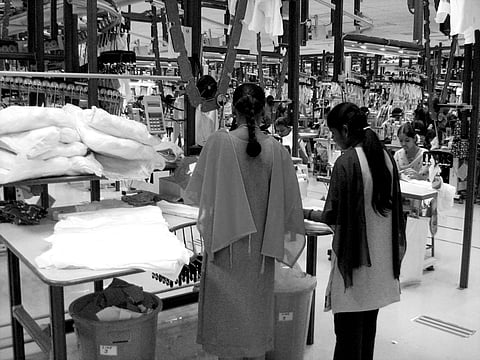Knitwear’s race to the bottom
Image: S Gautham
Every morning, dozens of buses arrive with relentless regularity at the high security gates of the Netaji Apparel Park in Tirupur. This is a brand-new, spic-and-span Industrial Estate at the outer bounds of the old town. The buses come from all directions, having snaked their ways through miles of dusty village tracks, with the precise, measured tread of an army convoy ferrying soldiers to a remote war post. At their destination, their blaring klaxons temporarily silenced by the screaming wails of banshee sirens announcing the start of a work shift, they disgorge hundreds of villagers. These are mostly young women, who disappear into the large factory complexes behind imposing, fortified gates. At every gate, a visitor is liable to find a torn-off piece of cardboard carton inscribed with two prominent legends: 'Labour Wanted' and 'No Child Labour'. Both are telling in their own way. The people consumed by this giant apparatus will emerge in due course – some after eight hours, but the majority after 12, perhaps 16, hours – trooping back into their allotted buses, to be ferried back to their villages.
Welcome to Tirupur, Tamil Nadu, also known variously as Knit City, T-Shirt City and sometimes even Dollar City. This is perhaps the only urban area in India with negative unemployment, with more jobs than there are people. It is for this reason that factories here are forced to haul in their workforce from as far as 60 kilometres away. Over two decades, Tirupur's growth has been exponential, rising from annual export revenue of INR 750 million (USD 12 million) in 1987 to more than INR 110 billion (USD 1.75 billion) in 2007. In more ways than one, Tirupur has become the beacon of New India.
In a pioneering 2004 study of the town and its business triumph, Sharad Chari of the London School of Economics attributed Tirupur's success to what he calls "Gounder toil". The Gounders are a Tamil-speaking community of landowning peasants, whose cultural homestead is in the region of Kongunadu, in northwest Tamil Nadu. Referring to the local translation for 'toil', Chari uses the term ulaippu, which is distinct from the Tamil for 'work'. He notes that the Tirupur peasant was quick to adapt first to cotton farming during the 1920s, and before long there were several flourishing Gounder estates, or thottams, feeding the spinning mills of Coimbatore. The Gounder peasants also evolved an intricate system through which to work their thottams, using both unpaid family labour and indentured Dalit workers.
The Gounders were game to get their own hands dirty, and actively took part in the labour. This work ethic coalesced into an intricate, informal, quasi-legal lending mechanism – a unique and crucial system of kinship-based venture funding. It allowed other apprentice clansmen to set up their own businesses. Migrant workers slowly became factory owners, which helped in the transition to small industry when the time was right. So much so that, when the rest of the agricultural and commodities markets collapsed during the economic depression of the 1930s, Tirupur grew by 117 percent. Decades later, during the 1970s and 1980s, Western retailers began to arrive, scouting for cheap production sources and found Tirupur ready. It has always been a city that responds to challenge with innovation.
Kaderpet knitwear
Local legend credits Ghulambhai Kader with having been the first of Tirupur's entrepreneurs. During the 1920s, Kader would not have had an inkling of the town's eventual success as he began knitting baniyans (cotton vests) in his backyard. For years thereafter, Tirupur did just that – made baniyans, while also ginning cotton from the surrounding fields. At that time, the town was a minor stop en route to the Coimbatore mills, 60 kilometers away.
As is true of so much of corporate wealth, Tirupur was able to benefit from the war economy. The Second World War saw a spiralling demand for cotton wear, which could not solely be met by Ludhiana, in Punjab, which had long been a knitwear hub. The Gounder entrepreneurs of Tirupur responded with customary élan, and today the town's watering holes resound with stories of Tirupur's millionaire families.
Residents will tell you that anyone not destitute in the city – bootleggers and brothel keepers, actuaries and activists – has at least a tangential hand in the knitwear till. Knitwear, after all, is everywhere. In the numerous tiny lanes that branch out of Tirupur's two or three exhaust-choked arterial roads, there is always a warren of still-narrower streets with tightly-packed houses, each one of them concealing a 'factory'. Each of these tiny workshops plays a minor role in the value chain that delivers branded clothes to metropolitan high streets the world over.
Ghulambhai Kader is today commemorated in the caverns of a neighbourhood named after him – Kaderpet. What goes on in Kaderpet is the throbbing flipside, the bottom end of the garment business, the very heart of Indian street chic. It is from here that 'export surplus' clothes find their way to street stalls from Shillong to Srinagar. Kaderpet is not a large market, just a street and a half. But it is crammed with buildings, each one a cul-de-sac – some new, with names like Fancy Complex, and others abandoned ginning factories. Their display shelves spill over into the narrow streets, each one packed with an incredible array of hosiery. Here, in the heart of Tamil country, everyone is a polyglot – the language of the street is market Hindustani, but if necessary, you can just as easily trade in Oriya or Kannada or Punjabi. The buyers come from all over, and it is a lucrative, hassle-free business. There is no credit, no bills – it is all just cash-and-carry.

